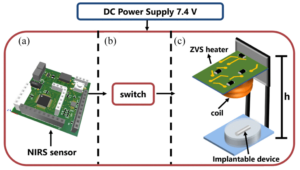
A figure from this article. Image copyright IEEE
A Wearable Device Towards Automatic Detection and Treatment of Opioid Overdose
Published in IEEE Transactions on Biomedical Circuits and Systems.
Authors
Juan C Mesa, Michael D MacLean, Maria Ms, Alan Nguyen, Rujuta Patel, Timothy Diemer, Jongcheon Lim, Chi Hwan Lee, Hyowon Lee
Paper presented by Dr. Agnieszka Sulima and selected by the NIDA TDI Paper of the Month Committee
Publication Brief Description
Opioid use disorder (OUD) and fatal overdose due to intentional and unintentional consumption of opioids, particularly fentanyl and fentanyl-laced mixtures, are emerging global concerns. According to CDC estimates, more than 81,000 deaths were attributed to opioids in 2022 alone. Accessibility to naloxone as a harm reduction intervention for people at risk for opioid overdose is critical in combating opioid-related deaths. Researchers at Purdue University demonstrated the feasibility of a minimally invasive automatic naloxone delivery system that can administer a dose of naloxone upon detection of overdose-induced respiratory failure. The system consists of (1) a near-infrared spectroscopy (NIRS) sensor for detecting hypoxia event, (2) a MOSFET switch driver to integrate the NIRS circuit to a zero-voltage switching (ZVS) driver, (3) a ZVS electromagnetic filed generator to activate a drug delivery device in the presence of hypoxia event, and (4) an implantable drug delivery capsule. It is the first wearable closed-loop device utilizing NIRS sensor to detect and treat an overdose event. Furthermore, the researchers demonstrated that the device is capable of a rapid, within 10 seconds, delivery of a dose of naloxone after detecting a hypoxic event. Although further studies and optimizations are needed, the proof-of-concept closed-loop naloxone delivery system has the potential to reduce opioid toxicity in the absence of bystanders.
A Wearable Device Towards Automatic Detection and Treatment of Opioid Overdose Journal Article
In: IEEE Trans Biomed Circuits Syst, vol. 18, no. 2, pp. 396–407, 2024, ISSN: 1940-9990.
